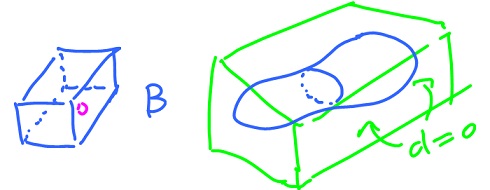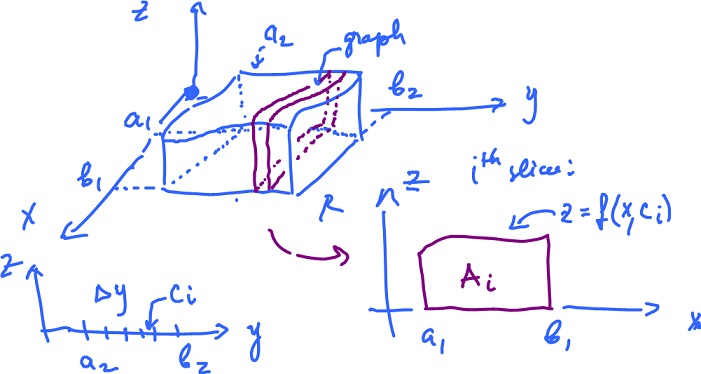This site is being phased out.
Mass as an integral
We need integrals to compute volumes of complicated figures and the mass of objects with non-uniform density.
We can certainly compute the volume of a box in any dimension but what about the ball, cylinder etc. Meanwhile the mass of even a simple figure isn't easy to compute unless it's made of uniform material.
Suppose we have a (real) box B filled with stuff of varied density. Mathematically, the situation is captured by a function
d: B → ℝ+,
and d( x, y, z ) is the density at the point ( x, y, z ).
What is the mass of B? Consider little cubes, each of volume ∆V, then estimate the density of each cube by
d( ei, dj, el ),
where ( ei, dj, el ) is a point in a cube. Then the estimated mass is
∑i,j,l d( ei, dj, el ) ∆V,
which we recognize as a Riemann sum. It converges, as k → 0, to
∫∫∫B d( x, y, z) dV.
Note: we can compute the volume of a complex figure G by putting it in a box and setting the density equal to zero in the complement B\G of G.
Example. Let
R = [ 0, 1 ] × [ 1, 2 ].
Then what is
∫∫R ( x2 y ) dA?
We can reduce the above definite integral to indefinite integrals (i.e. antiderivatives), just like in Calc 1. Except now we have two variables. of x and y.
The idea is to cut the region into slices and compute the volume of each as a single integral, then add them.
Subdivide
∆y = ( b2 - a2 ) / k.
Suppose
the area of the i-th slice is Ai.
Then the volume equals the sum of the volumes of the slices, which is approximately
V ≈ ∑i=1k Ai ∆y
(i.e. the area of the cross section multiplied with the thickness). Find, by the Fundamental Theorem of Calculus,
Ai = ∫[a1,b1] f( x1, ci ) dx
= ∫a1b1 f( x1, ci ) dx,
substitute:
volume ≈ ∑i=1k ( ∫a1b1 f( x1, ci ) dx ) ∆y volume = limk→∞ ∑i=1k [ ∫a1b1 f( x1, ci ) dx ] ∆y.
The sum in the above formula is a Riemann sum with respect to y on [ a2, b2 ], but of what? Compare the above to
limk→∞ ∑i=1k g( ci ) ∆y = ∫a2b2 g(y) dy.
What is g?
g(y) = ∫a1b1 f( x, y ) dx.
The limit is the Riemann integral:
volume = ∫a2b2 ∫a1b1 f( x, y ) dx dy.
These are definite integrals (dimension 1). They are computed by the FTC. For our specific function we have:
= ∫01 ( ∫01 x2 y dx ) dy
= ∫01 ( 1 / 3 x3 y |x=0x=1 ) dy
= ∫01 ( 1 / 3 y - 0 ) dy
= y2 / 6 |01 = 1 / 6.

